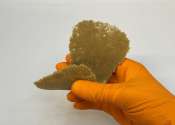A nappy (in the United Kingdom, Ireland, Australia, New Zealand and many other Commonwealth countries) or a diaper (in North America) is a kind of pant that allows one to defecate or urinate on oneself discreetly. When diapers become soiled, they require changing; this process is often performed by a second person such as a parent or caregiver. Failure to change a diaper on a regular enough basis can result in diaper rash.
Diapers have been worn throughout human history. They are made of cloth or disposable materials. Cloth diapers are composed of layers of fabric such as cotton, hemp, bamboo or microfiber and can be washed and reused multiple times. Disposable diapers contain absorbent chemicals and are thrown away after use. The decision to use cloth or disposable diapers is a controversial one, owing to issues ranging from convenience, health, cost, and their effect on the environment. Plastic pants can be worn over diapers to avoid leaks, but with modern cloth diapers, this is no longer necessary.
Diapers are primarily worn by children who are not yet potty trained or experience bedwetting. However, they can also be used by adults with incontinence or in certain circumstances where access to a toilet is unavailable. These can include the elderly, those with a physical or mental disability, and people working in extreme conditions such as astronauts. It is not uncommon for people to wear diapers under dry suits. Diapers are usually worn out of necessity rather than choice, although there are exceptions; people such as infantilists and diaper fetishists wear diapers recreationally for comfort, emotional fulfillment, or sexual gratification. Terms such as "incontinence pads" can be used to refer to adult diapers.
An alternative to infant diapers is the infant potty training method or elimination communication, a technique that involves sound association, learning an infant’s body language, and reacting quickly enough to reach a suitable spot for elimination. This method is more commonly used in third-world countries whose citizens do not possess the financial means to purchase baby diapers.







